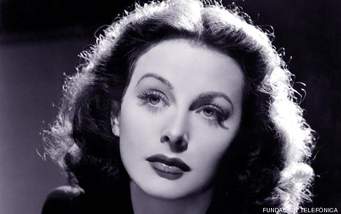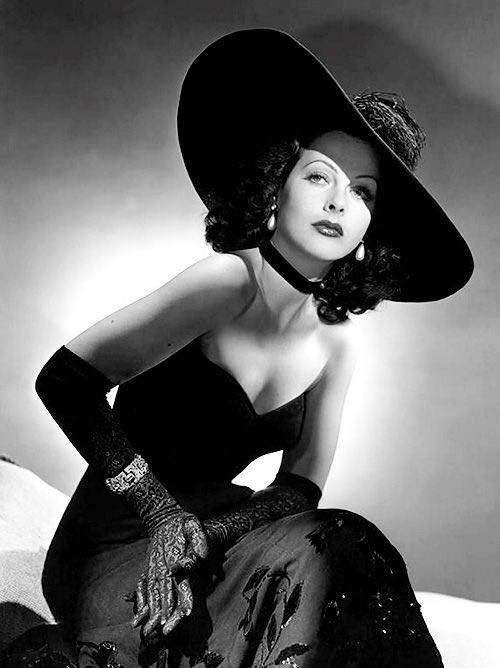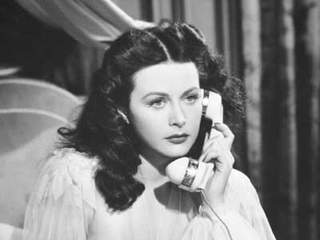
Summary: She was born in Vienna to Emil Kiesler, a bank director, and Gertrud née Lichtwitz, pianist. Though part Jewish, she was raised as Catholic,and studied ballet and piano.
BIOGRAPHICAL DETAILS
Full Name: Hedwig Eva Maria Kiesler
Description: Actress, Algiers
Known For: Film – “The Heavenly Body” (1944)
Location: United States of America
Date Born: 9th November 1913
Location Born: Vienna, Austria
Date Died: 9th January 2000
Location Died: Altomote Springs, Florida, United States of America
Cause Of Death: Not known
Photo Comments: This work is in the public domain.
CONTACT DETAILS
Web Site:
Other Links: See below:
YOUTUBE VIDEO
BIOGRAPHICAL PROFILE
Hedy Lamarr
An Austrian-born American actress, celebrated for her great beauty, who was a major contract star of MGM’s “Golden Age”.
Lamarr also co-invented – with composer George Antheil – an early technique for spread spectrum communications and frequency hopping, necessary to wireless communication from the pre-computer age to the present day.
Lamarr was born Hedwig Eva Maria Kiesler in Vienna, Austria-Hungary, the only child of assimilated Jewish parents. Her mother, Gertrud, was a pianist and Budapest native who came from the “Jewish haute bourgeoisie”, and her father, Lemberg-born Emil Kiesler, was a successful bank director.
In early 1933 she starred in Gustav Machatý’s notorious film Ecstasy, a Czechoslovak film made in Prague, in which she played the love-hungry young wife of an indifferent older husband. Closeups of her face during orgasm in one scene (rumored to be unsimulated), and full frontal shots of her in another scene, swimming and running nude through the woods, gave the film great notoriety.
On August 10, 1933, aged 19, she married Friedrich Mandl, a Vienna-based arms manufacturer 13 years her senior.
In her autobiography Ecstasy and Me, Lamarr described Mandl as an extremely controlling man who sometimes tried to keep her shut up in their mansion. Mandl bought as many copies of Ecstasy as he could possibly find, objecting to her in the film, and “…the expression on her face.”
Lamarr in her autobiography, objecting to the rumors about real sex, admitted that her costar had indeed played the scene with her using “method acting reality,” but she also stated that the film’s director had simulated looks of passion from offscreen by poking her in the bottom with a safety pin.
Mandl prevented her from pursuing her acting career, and instead took her to meetings with technicians and business partners. In these meetings, the mathematically talented Lamarr learned about military technology. Otherwise she had to stay at their castle home, Schloss Schwarzenau.
She later related that, although Mandl was part-Jewish, he consorted with Nazi industrialists. In Ecstasy and Me, Lamarr wrote that Benito Mussolini and Adolf Hitler attended Mandl’s grand parties.
She related that in 1937 she disguised herself as one of her maids and fled to Paris, where she obtained a divorce, and then moved to London.
According to another version of the episode, she persuaded Mandl to allow her to attend a party wearing all her expensive jewelry, later drugged him with the help of her maid, and made her escape out of the country with the jewelry.
First she went to Paris, then met Louis B. Mayer in London. After he hired her, at his insistence, she changed her name to Hedy Lamarr, choosing the surname in homage to a beautiful film star of the silent era, Barbara La Marr, who had died in 1926 from tuberculosis.
In Hollywood, she was usually cast as glamorous and seductive. Her American debut was in Algiers (1938). Her many films include Boom Town (1940) with Clark Gable and Spencer Tracy, Comrade X with Gable, White Cargo (1942), and Tortilla Flat (1942) with Tracy and John Garfield, based on the novel by John Steinbeck.
In 1941, she was cast alongside two other Hollywood beauties, Lana Turner and Judy Garland in the musical extravaganza Ziegfeld Girl.
Lamarr made 18 films from 1940 to 1949 even though she had two children during that time (in 1945 and 1947).
After leaving MGM in 1945, she enjoyed her biggest success as Delilah in Cecil B. DeMille’s Samson and Delilah, the highest-grossing film of 1949, with Victor Mature as the Biblical strongman. However, following her comedic turn opposite Bob Hope in My Favorite Spy (1951), her career went into decline.
She appeared only sporadically in films after 1950, one of her last roles being that of Joan of Arc in Irwin Allen’s critically panned epic The Story of Mankind (1957).
The publication of her autobiography Ecstasy and Me (1967) took place about a year after accusations of shoplifting, and a year after Andy Warhol’s short film Hedy (1966), also known as The Shoplifter. The shoplifting charges coincided with a failed return to the screen in Picture Mommy Dead (1966). The role was ultimately filled by Zsa Zsa Gabor. Ecstasy and Me begins in a despondent mood, with this reference:
Frequency-hopping spread-spectrum inventionAvant garde composer George Antheil, a son of German immigrants and neighbor of Lamarr, had experimented with automated control of musical instruments, including his music for Ballet Mécanique, originally written for Fernand Léger’s 1924 abstract film. This score involved multiple player pianos playing simultaneously.
Lamarr took her idea to Antheil and together, Antheil and Lamarr submitted the idea of a secret communication system in June 1941. On August 11, 1942, US Patent 2,292,387 was granted to Antheil and “Hedy Kiesler Markey”, Lamarr’s married name at the time. This early version of frequency hopping used a piano roll to change between 88 frequencies and was intended to make radio-guided torpedoes harder for enemies to detect or jam. Although a presentation of the technique was soon made to the U.S. Navy, it met with opposition and was not adopted.
The idea was not implemented in the USA until 1962, when it was used by U.S. military ships during a blockade of Cuba after the patent had expired.
Perhaps owing to this lag in development, the patent was little-known until 1997, when the Electronic Frontier Foundation gave Lamarr an award for this contribution.
It is reported that, in 1998, Ottawa wireless technology developer Wi-LAN, Inc. “acquired a 49 percent claim to the patent from Lamarr for an undisclosed amount of stock” (Eliza Schmidkunz, Inside GNSS), although expired patents have no economic value. Antheil had died in 1959.
Lamarr’s and Antheil’s frequency-hopping idea serves as a basis for modern spread-spectrum communication technology, such as Bluetooth, COFDM used in Wi-Fi network connections, and CDMA used in some cordless and wireless telephones.
Blackwell, Martin, and Vernam’s 1920 patent Secrecy Communication System (1598673) seems to lay the communications groundwork for Kiesler and Antheil’s patent, which employed the techniques in the autonomous control of torpedoes.
Lamarr wanted to join the National Inventors Council, but was reportedly told by NIC member Charles F. Kettering and others that she could better help the war effort by using her celebrity status to sell War Bonds. She once raised $7,000,000 at just one event.
The 1970s were a decade of increasing seclusion for Lamarr. She was offered several scripts, television commercials, and stage projects, but none inspired her interest.
In 1974, Lamarr filed an invasion of privacy lawsuit to the tune of $10 million for the unauthorized use of her name in the Mel Brooks satire Blazing Saddles; the case was settled out of court.
Tired of the life of a celebrity and with her eyesight failing, Lamarr retreated from public life and settled in Miami Beach, Florida, in 1981.
Hedy Lamarr has a star on the Hollywood Walk of Fame at 6247 Hollywood Blvd.
Lamarr died in Altamonte Springs, Florida in 2000.
Films include
Das Geld liegt auf der Straße (1930)
Die Frau von Lindenau (1931)
Die Abenteuer des Herrn O. F. (1931)
Man braucht kein Geld (1932)
Ekstase / Symphonie der Liebe (1933)
Algiers (1938)
Hollywood Goes to Town (1938)
Screen Snapshots: Stars at a Charity Ball (1939)
Lady of the Tropics (1939)
I Take This Woman (1940)
Boom Town (1940)
Comrade X (1940)
Come Live with Me (1941)
Ziegfeld Girl (1941)
H.M. Pulham, Esq. (1941)
Tortilla Flat (1942)
Crossroads (1942)
White Cargo (1942)
Show Business at War (1943)
The Heavenly Body (1944)
The Conspirators (1944)
Experiment Perilous (1944)
Her Highness and the Bellboy (1945)
The Strange Woman (1946)
Dishonored Lady (1947)
Let’s Live a Little (1948)
Samson and Delilah (1949)
A Lady Without Passport (1950)
Copper Canyon (1950)
My Favorite Spy (1951)
Loves of Three Queens (1954)
The Story of Mankind (1957)
The Female Animal (1958
From Wikipedia, the free encyclopedia


